Each quarter I post the current state of my peer to peer lending accounts. I am a lender who enjoys maximizing my return through fine-filtering available loans with the highest interest available.
As you can see in the following table, I continue to celebrate positive returns on both Lending Club and Prosper.

Figuring Out ROI Can Be Tough
Calculating your peer to peer lending ROI (return on investment) is tricky business. If you want the easy route, both Lending Club and Prosper offer you their sometimes inflated number. Calculating your ROI with XIRR through Excel is probably the best, but this still does not take into account any notes that have gone late (and are, as such, no longer worth their full value). Michael’s Portfolio Analyzer at NSR includes a reduction from these late notes, but does not do well with loans bought or sold on the secondary market (which I have done many times). I have included on-site and XIRR ROIs for comparison’s sake (see my analysis of calculating XIRR return).
Accounts Breakdown
On average, my returns stayed the same this quarter as last quarter.
Prosper Taxable Account: 12.52% ROI
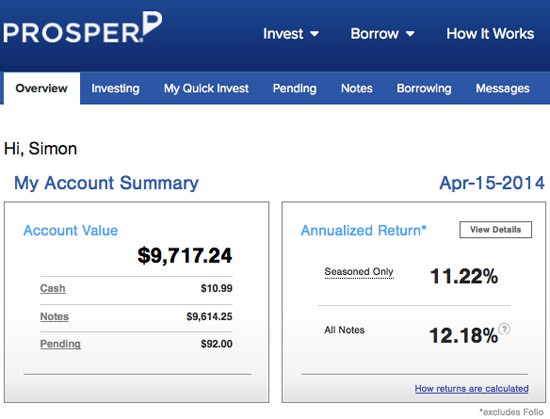
I added an extra $2,000 last quarter, and you can see it in the lowered average note age and the fact that my Prosper overall return rose by 6 basis points. For what it’s worth, I introduced C-grade loans into my Prosper account this quarter, and you can see it by the fact that the average interest rate on the loans I am investing in dropped from 26.89% to 25.28%.
I have earned almost $3,000 in interest on this account, but nearly half that amount (46%) has been lost in principal to defaulting borrowers. This large loss is a result of the higher-risk borrowers I am investing in. Considering my overall return remains above 12%, I am comfortable with this huge-up & huge-down approach. In my investing strategy (and at my age), I actually find this tumultuous toss a lot of fun.
I do not recommend this higher-risk higher-reward approach for most investors, especially for those starting out. That said, it continues to work well for me, and I plan on continuing this practice into the near future.
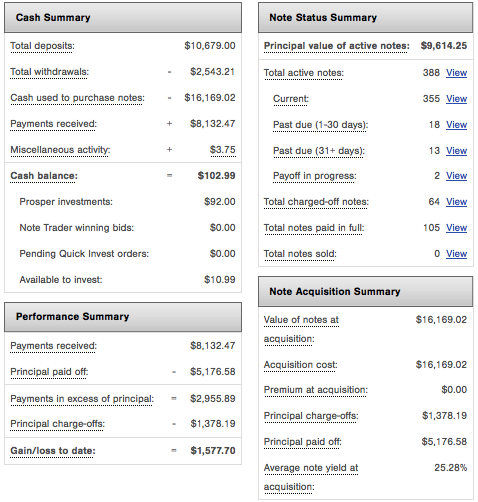
Lending Club Roth IRA: 13.10% ROI
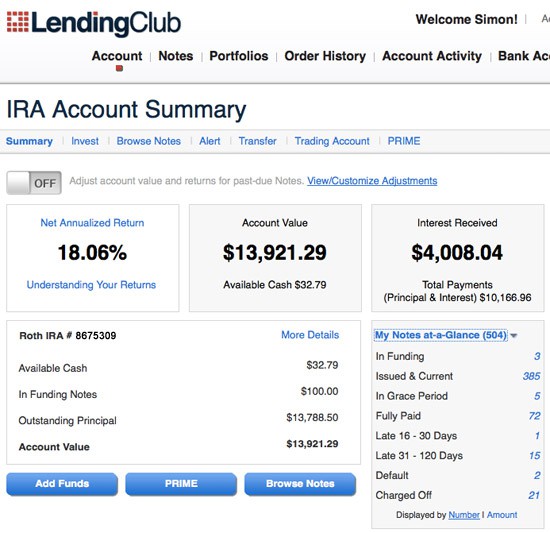
This account has been enjoyable as well. For those not keeping track, I experienced my largest number of defaults ever this quarter – ten loans in all, and will probably accrue additional ones in the next quarter. That said, my overall return remains above 13%. I continue to push for returns on this account through smart note selections. My average weighted rate (the interest rate of loans I invest in) continues to inch upward, going from 21.28% to 21.36%.
It is worth mentioning again that I used to sell notes that had gone late by using my Sell Late Notes on Foliofn strategy. Unfortunately, Lending Club has gently informed their lending community that this is now not allowed. There has not been an official announcement yet – just the top gray box on this page. However, you can read the continuing saga on this topic over at the Lend Academy forum (Thread: Folio and IRAs). (UPDATE: Trading through an IRA is now allowed again!)
Just 14% of my Lending Club notes have a 36-month term, and the average grade is E3. Similar to my Prosper account, I do not recommend such a higher-risk higher-return approach for most investors.
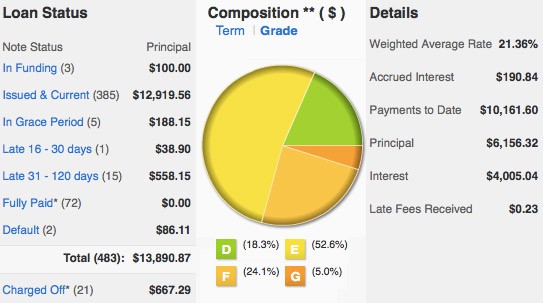
Riding the Return Curve
As outlined in my Riding the Return Curve post, my overall return continues to slightly drop as my account matures.
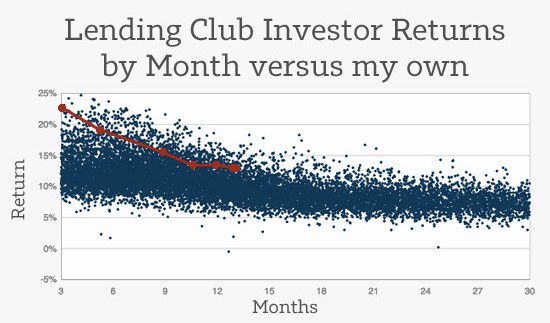
It is interesting to see how I continue to beat out the majority of Lending Club investors. I attribute this to the various strategies I employ, as well as patience and a bit of luck. I will be coming out with a post in the coming month regarding the filters I use on these accounts, though investors who have been in the game a while will not find any real surprises.
More than anything, I continue to be amazed by the reality of peer to peer lending. This thing works. This quarterly update, like those that came before it, prove this asset class to be both real and lucrative.
Tell you wives. Tell your friends. Things are changing. In fifty years from now when lending money to responsible people is the norm, we’ll all look back and shake our heads at the task most Americans faced in the late nineties when the mainstream way to save for retirement was corporation-based mutual funds.
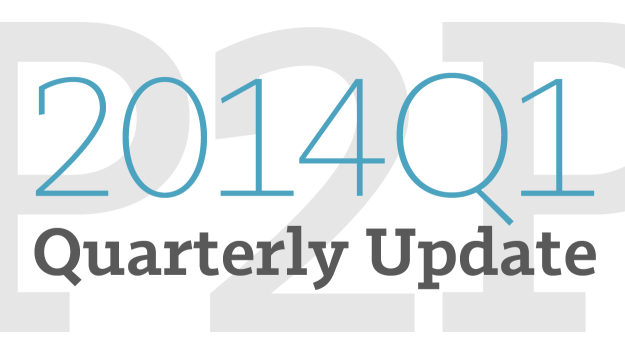
You’ve given your 36/60-month note breakdown for Lending Club, but out of curiosity, what is your overall breakdown between both accounts? For example, I will invest in both 36 and 60-month notes for Lending Club, but only 36-month notes for Prosper. Based on my analysis, albeit limited and probably inefficient in nature, I haven’t seen where Prosper prices the 60-month notes I’d be interested in effectively to account for the additional two years of amortization.
It goes without saying, your accounts are performing quite well given their relative age and point on the default curve. Double digit returns are not something to sneeze at, that’s for certain!
Thanks Adam. 57% 36-month loans for Prosper. My charge-offs are almost exactly this ratio as well: 60.4% are 36-month loans.
I’m really interested why my Prosper on-site return is actually lower than my XIRR calculation. That is a first.
Are you concerned at all about the number of loans that are available for you to invest in? It seems these numbers are small and with the big boys and the automation does it leave enough out there (of value) for the little guy?
Hi Jeff. Loan availability at Lending Club remains strong. Prosper is tougher, largely because they have been so focused on retail. However, I have a solid API investing tool for both, so my availability is fine at Prosper.
In short, if you’re a little guy, Lending Club is currently the place to hang your hat.
Great returns Simon. Actually, quite amazing! As a retiree I am investing in Prosper with A,B,C, and a few D,E loans (400+). The sweet spot for me seems to be in the B-C area. At this point (six months) I do not have any charge-offs but have about 8 paid-off loans. Of course, I expect this to change over the next six months. Now I’m earning about 11-12% with my own filters. I’ll be happy with 8-9% towards the 12 month mark.
These are great returns. I look at my accounts on monthly basis (XIRR, annualized, etc.) This is in contrast to tracking overall ROI from account inception. Measuring monthly returns, with at least one of my aged account, painted a very bleak picture (I did use PRIME with minimal filtering efforts for D+ notes).
First 10 months returns are great 15%+, but after they promptly dropped to 0%-5%. It looks like initial several good months really skew the picture. In aged accounts, new loans purchases are balanced with pay-offs, i.e. steady state investors should consider for long-term accounts. I would be very curious to know what your annualized monthly returns on these old accounts where no significant cash infusions were made in at least 2 years?
Thanks. As to your point, I don’t plan on injecting any additional cash in these accounts so as to come to some sort of 24month ROI measurement point like what you’re saying.
Hi Simon:
Thanks for the wealth of information you have provided on this site. I just recently opened my Lending Club account last month to diversify a bit away from stocks which are getting a little pricy now. I am essentially following all your advice, diversifying by buying 200+ notes at $25 each, buying E, F, G grades only, filtering out public records, recent inquiries, small business, income less than 5000, and California. I am hoping for 10%+ annual return. What additional advice for a novice like me starting out?
Also, what percentage of your total investment portfolio do p2p loans comprise? Historically stocks have returned 10% annually and they get favorable tax treatments, so essentially p2p loans would have to get around 12-13% pretax return to get the same return as stocks after tax, which may not be achievable. I’m interested in what you think would be an appropriate allocation for p2p loans in an overall portfolio for a young investor. Many thanks!
Hi Difu. I can’t speak to your particular situation, but it seems that investors who want to only invest in Es, Fs, and Gs should diversify in 300 notes. Otherwise. I would just invite you to enjoy this thing. It’s a fabulous way to invest.
Also, as for allocation, the general consensus is 10%, though your situation may warrant a different balance.
Hi Simon,
It appears your IRA is with Lending Club and your non-IRA with Prosper. Any reason for this?
Hi Ernie. Simply put, Lending Club was my first platform, so I went with them for my first IRA. Not a huge difference though.
Arguably, a good tax strategy would be to have a higher risk/return account in a IRA and a more low risk/return in a regular taxable account.
Thanks, Si.
My returns in 2017 are down from nearly 5% to just over 2%. In both of my accounts.
I’m turning off auto invest. Also, very skeptical of how they do things. Not sure there’s enough transparency.